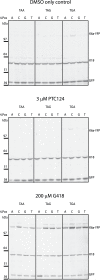A lack of premature termination codon read-through efficacy of PTC124 (Ataluren) in a diverse array of reporter assays
- PMID: 23824517
- PMCID: PMC3692445
- DOI: 10.1371/journal.pbio.1001593
A lack of premature termination codon read-through efficacy of PTC124 (Ataluren) in a diverse array of reporter assays
Abstract
The drug molecule PTC124 (Ataluren) has been described as a read-through agent, capable of suppressing premature termination codons (PTCs) and restoring functional protein production from genes disrupted by nonsense mutations. Following the discovery of PTC124 there was some controversy regarding its mechanism of action with two reports attributing its activity to an off-target effect on the Firefly luciferase (FLuc) reporter used in the development of the molecule. Despite questions remaining as to its mechanism of action, development of PTC124 continued into the clinic and it is being actively pursued as a potential nonsense mutation therapy. To thoroughly test the ability of PTC124 to read through nonsense mutations, we conducted a detailed assessment comparing the efficacy of PTC124 with the classical aminoglycoside antibiotic read-through agent geneticin (G418) across a diverse range of in vitro reporter assays. We can confirm the off-target FLuc activity of PTC124 but found that, while G418 exhibits varying activity in every read-through assay, there is no evidence of activity for PTC124.
Conflict of interest statement
I have read the journal's policy and have the following conflicts. We discovered the lack of efficacy of PTC124 by conducting our own drug discovery programme to discover and develop nonsense mutation read-through agents. Subsequent to the completion of this work, WHIM initiated a partnership with Glaxo SmithKline (GSK) on a closely related project. The work described herein was conducted prior to, and independently of, any interaction with GSK. No materials or support were received from GSK and no agreements are in place with GSK concerning the execution or publication of this work, although they were at one point involved in discussions about its publication. The collaboration with GSK has now ended.
Figures





Comment in
-
A read-through drug put through its paces.PLoS Biol. 2013;11(6):e1001458. doi: 10.1371/journal.pbio.1001458. Epub 2013 Jun 25. PLoS Biol. 2013. PMID: 23824301 Free PMC article. No abstract available.
References
-
- Nicholson P, Muhlemann O (2010) Cutting the nonsense: the degradation of PTC-containing mRNAs. Biochem Soc Trans 38: 1615–1620. - PubMed
-
- Kellermayer R (2006) Translational readthrough induction of pathogenic nonsense mutations. Eur J Med Gen 49: 445–450. - PubMed
-
- Welch EM, Barton ER, Zhuo J, Tomizawa Y, Friesen WJ, et al. (2007) PTC124 targets genetic disorders caused by nonsense mutations. Nature 447: 87–91. - PubMed
Publication types
MeSH terms
Substances
Grants and funding
LinkOut - more resources
Full Text Sources
Other Literature Sources

